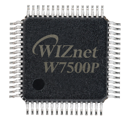W7500P

The IOP4IoT W7500P chip is the one-chip solution which integrates an ARM Cortex-M0, 128KB Flash, hardwired TCP/IP core for various embedded application platform, 10/100 Ethernet MAC and PHY, and especially internet of things. The TCP/IP core is a market-proven hardwired TCP/IP stack and PHY is IC plus IP101G, an IEEE 802.3/802.3u Fast Ethernet Transcevier for 10/100Mbps. The Hardwired TCP/IP stack supports the TCP, UDP, IPv4, ICMP, ARP, IGMP and PPPoE which has been used in various applications for more than 15 years. W7500P suits users who need Internet connectivity best.
Features
- ARM Cortex-M0
- 48MHz maximum frequency
- Hardwired TCP/IP Core
- 8 Sockets
- SRAM for socket: 32 KB
- PHY
- IC+(IP101G)
- Memories
- Flash: 128 KB
- SRAM: 16KB
- ROM for boot code: 6 KB
- Clock, reset and supply management
- POR (Power-On Reset)
- Internal Voltage Regulator : 3.3V to 1.5V
- 8-to-24MHz external crystal oscillator
- Internal 8MHz RC Oscillator
- PLL for CPU clock
- ADC : 12bit, 8ch, 1Msps
- DMA
- 6-channel DMA controller
- Peripheral supported: UARTs, SPIs
- GPIO
- 34 I/Os (15 IO x 2ea, 4 IO x 1ea)
- Debug mode
- Serial Wire Debug (SWD)
- Timer/PWM
- 1 Watchdog (32-bit down-counter)
- 4 Timers (32-bit or 16-bit down-counter)
- 8 PWMs (32-bit counter/timers with programmable 6-bit prescaler)
- Communication Interfaces
- 3 UART (2 UARTs with FIFO and Flow Control, 1 simple UART)
- 2 SPI
- Crypto
- 1 RNG (Random Number Generator): 32-bit random number
- Package
- 64 LQFP (7x7 mm)